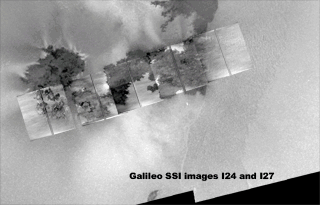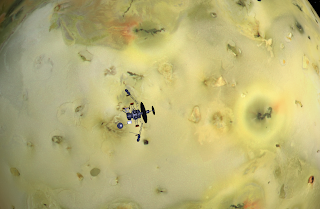 Welcome to the 126th Edition of the Carnival of Space! Each week, the Carnival of Space is hosted by different blogs and provides links to the best in the space and astronomy blogosphere so everyone can be kept up-to-date. We are this week's hosts! For earlier editions of the CoS, or if you want to learn how you too can participate in the Carnival, check out the Carnival of Space archive at the Universe Today.
Welcome to the 126th Edition of the Carnival of Space! Each week, the Carnival of Space is hosted by different blogs and provides links to the best in the space and astronomy blogosphere so everyone can be kept up-to-date. We are this week's hosts! For earlier editions of the CoS, or if you want to learn how you too can participate in the Carnival, check out the Carnival of Space archive at the Universe Today. Now, since I learned I would host the Carnival of Space, I wracked my brain on how I would organize the links. Would I go the traditional route, outward from the sun? Would I go from smallest celestial body to largest, or vice versa? This week's carnival is the first Carnival to be hosted on Jupiter's innermost large satellite, Io, and in honor of that fact, I thought it would be a nice change of pace to go in order of least "active" to most "active", in terms of the amount of internal energy escapes that body.
 We will start first at the Moon. In recent years, various space agencies around the world have been racing to send unmanned probes to our nearest celestial neighbor. In NASA's most recent entry, the LCROSS satellite and its Centaur booster impacted within a permanently shadowed area near the Moon's south pole on October 9 in search of water. Phil Plait at Bad Astronomy took a look a look at the mission's "impact" on his fellow Earthlings versus the spacecraft's actual impact on the Moon. The discovery of a lava tube skylight by Japan's Kaguya spacecraft inspired blog posts by Emily Lakdawalla at the Planetary Society Blog, focusing on Kaguya's results, and by Ian O'Neill at Astro Engine, who took a look at the discovery's impact on possible human settlement of the Moon. For a bit of a historical perspective on the future of manned exploration of the Moon, Louise Riofrio at A Babe in the Universe took a look at Apollo moon samples and reflected on the Apollo missions' impact on life here on Earth. Finally, Hui Chieh at My Dark Sky showed off some great images of a crescent moon as imaged from Pulau Tioman, Malaysia.
We will start first at the Moon. In recent years, various space agencies around the world have been racing to send unmanned probes to our nearest celestial neighbor. In NASA's most recent entry, the LCROSS satellite and its Centaur booster impacted within a permanently shadowed area near the Moon's south pole on October 9 in search of water. Phil Plait at Bad Astronomy took a look a look at the mission's "impact" on his fellow Earthlings versus the spacecraft's actual impact on the Moon. The discovery of a lava tube skylight by Japan's Kaguya spacecraft inspired blog posts by Emily Lakdawalla at the Planetary Society Blog, focusing on Kaguya's results, and by Ian O'Neill at Astro Engine, who took a look at the discovery's impact on possible human settlement of the Moon. For a bit of a historical perspective on the future of manned exploration of the Moon, Louise Riofrio at A Babe in the Universe took a look at Apollo moon samples and reflected on the Apollo missions' impact on life here on Earth. Finally, Hui Chieh at My Dark Sky showed off some great images of a crescent moon as imaged from Pulau Tioman, Malaysia.The next most active place we shall visit is Mars. The Mars Exploration Rovers continue to chug along at Gusev and Meridiani Planum. Well, Opportunity is anyway. That rover continues to make its way toward the crater Endeavour, checking out meteorites along the way. Stuart Atkinson at Road To Endeavour brings his poetic license to the latest of these, Mackinac. At Beyond Apollo, David Portree showed off pictures of models of a canceled pre-Viking, Mars lander, the Automatic Biological Laboratory, currently at the New Mexico Museum of Natural History and Science.
 From Mars, we move back toward the Sun to our own planet, Earth. More specifically, let's take a look at what folks were talking about regarding the exploration of space by sentient primates from that volcanically active world. The big news of the week was the release of the final report from the Augustine Commission, a committee that took a look at the current state of the United States' manned spaceflight program, where it should be directed over the next two decades, and how NASA's budget should be adjusted to meet those goals. Nancy Atkinson at Universe Today and Steinn Sigurdsson at Dynamics of Cats both provide an overview and their opinions regarding this report. Chuck Black at Commercial Space compares the chairman of the commission, Norm Augustine, to Liber Augustin and Augustine's 1990 assessment of the US manned spaceflight program. One issue highlighted in the Augustine report is the need for NASA to work with private spaceflight endeavors. Alan Boyle at MSNBC's Cosmic Log provides two reports from the ISPCS conference in New Mexico. These posts examine the need for the public and private spaceflight programs to work together and low-cost commercial spaceflight. 21st Century Waves has an interview with Stephen Ashworth and examines whether the optimism in spaceflight seen in the Apollo era might be making a comeback.
From Mars, we move back toward the Sun to our own planet, Earth. More specifically, let's take a look at what folks were talking about regarding the exploration of space by sentient primates from that volcanically active world. The big news of the week was the release of the final report from the Augustine Commission, a committee that took a look at the current state of the United States' manned spaceflight program, where it should be directed over the next two decades, and how NASA's budget should be adjusted to meet those goals. Nancy Atkinson at Universe Today and Steinn Sigurdsson at Dynamics of Cats both provide an overview and their opinions regarding this report. Chuck Black at Commercial Space compares the chairman of the commission, Norm Augustine, to Liber Augustin and Augustine's 1990 assessment of the US manned spaceflight program. One issue highlighted in the Augustine report is the need for NASA to work with private spaceflight endeavors. Alan Boyle at MSNBC's Cosmic Log provides two reports from the ISPCS conference in New Mexico. These posts examine the need for the public and private spaceflight programs to work together and low-cost commercial spaceflight. 21st Century Waves has an interview with Stephen Ashworth and examines whether the optimism in spaceflight seen in the Apollo era might be making a comeback.Looking further into the future of human spaceflight, Weird Warp talks about the potential of moonbases and their requirements. At The Next Big Future, Brian Wang notes the upcoming Space Elevator Games beaming competition and has a cool trailer. Triggered by a 1997 article by Freeman Dyson, Music of the Spheres discusses the prospects and the possible timing for our expansion into the Greater Solar System. Looking at spaceflight today, Robert Pearlman at collectSPACE talks about a scarf owned by Amelia Earhart that will taken up into space on the Shuttle Atlantis next month by her photographer's grandson. Cheap Astronomy presents their IYA 365 Days of Astronomy podcast covering the TDRS system, a group of satellites used to communicate with International Space Station and the Space Shuttle, for example.
Looking at Earth, beyond just the exploration of its nearby space by humans, Robert Simpson at Orbiting Frog discusses fun ways to destroy our home planet. I like death by Heisenberg Uncertainty Principle myself. Another potential way to destroy our planet may be balloon boy hoax stories in the media, which Ray Villard at Cosmic Ray examines with an eye towards the media's interest in pseudoscience.
From Earth, we go to the most volcanically active moon in the Solar System, Jupiter's moon Io. From this blog, I summarized a paper presenting a new geologic map of the volcano Prometheus, the site of a persistently active volcanic plume.
 Finally, we move beyond the Earth and move out into the wider, more energetic universe, in this case looking at astronomy here on Earth. Robert Simpson suggests checking out the Astronomy Stars project, a South African site with tips and advice on how to communicate astronomy to the public and the media. For those with a space blog or are considering starting one, this site is a great resource. Alice's Astro Info has a video providing tips for buying your first telescope (you may not like her first answer...). Steve's Astro Corner has a post about the Cincinnati Observatory on Mt. Adams, what he calls the birthplace of American astronomy. The Chandra Blog, which focuses the results and observations of Chandra X-Ray Space Observatory, takes a look at a new visualization of the Chandra Source Catalog, a collection of information of all of Chandra's observations imported into Google Sky.
Finally, we move beyond the Earth and move out into the wider, more energetic universe, in this case looking at astronomy here on Earth. Robert Simpson suggests checking out the Astronomy Stars project, a South African site with tips and advice on how to communicate astronomy to the public and the media. For those with a space blog or are considering starting one, this site is a great resource. Alice's Astro Info has a video providing tips for buying your first telescope (you may not like her first answer...). Steve's Astro Corner has a post about the Cincinnati Observatory on Mt. Adams, what he calls the birthplace of American astronomy. The Chandra Blog, which focuses the results and observations of Chandra X-Ray Space Observatory, takes a look at a new visualization of the Chandra Source Catalog, a collection of information of all of Chandra's observations imported into Google Sky.I hope you all enjoyed this tour of this week's best of the space blogosphere. Hope you all have a great week!

































